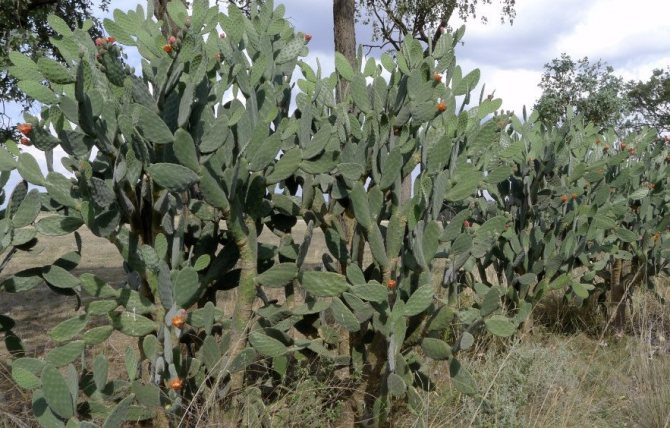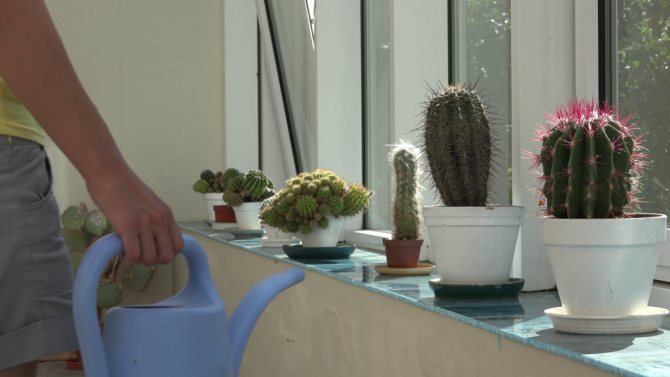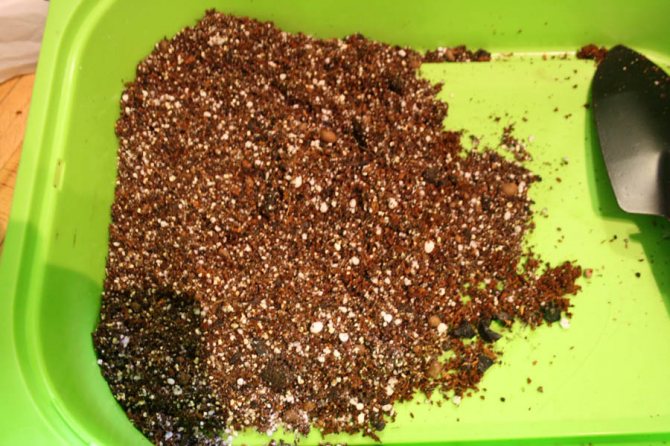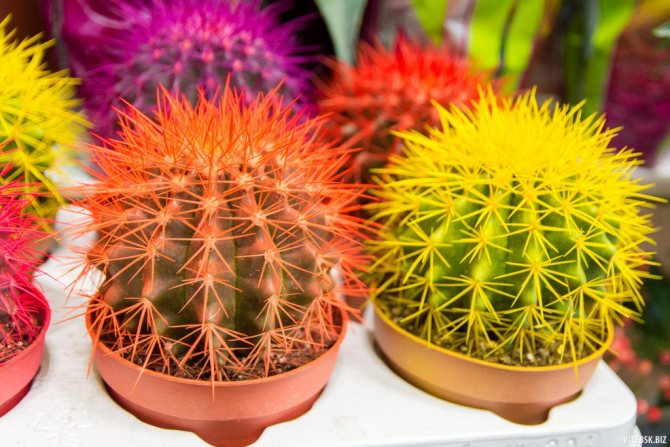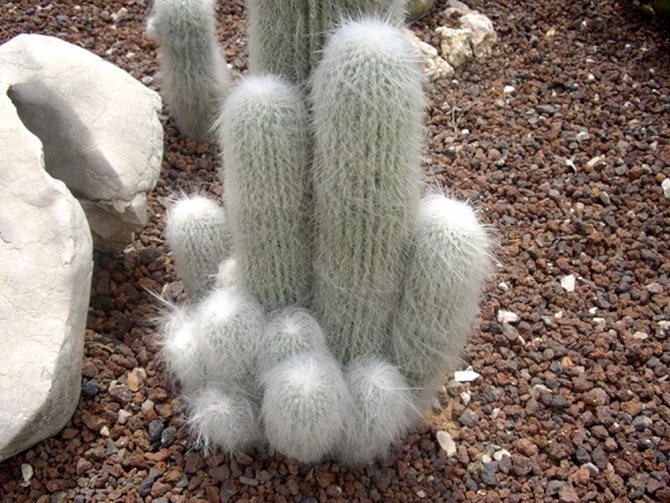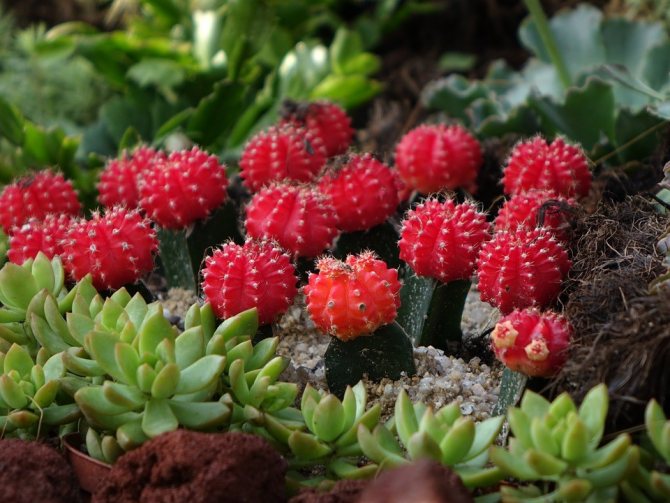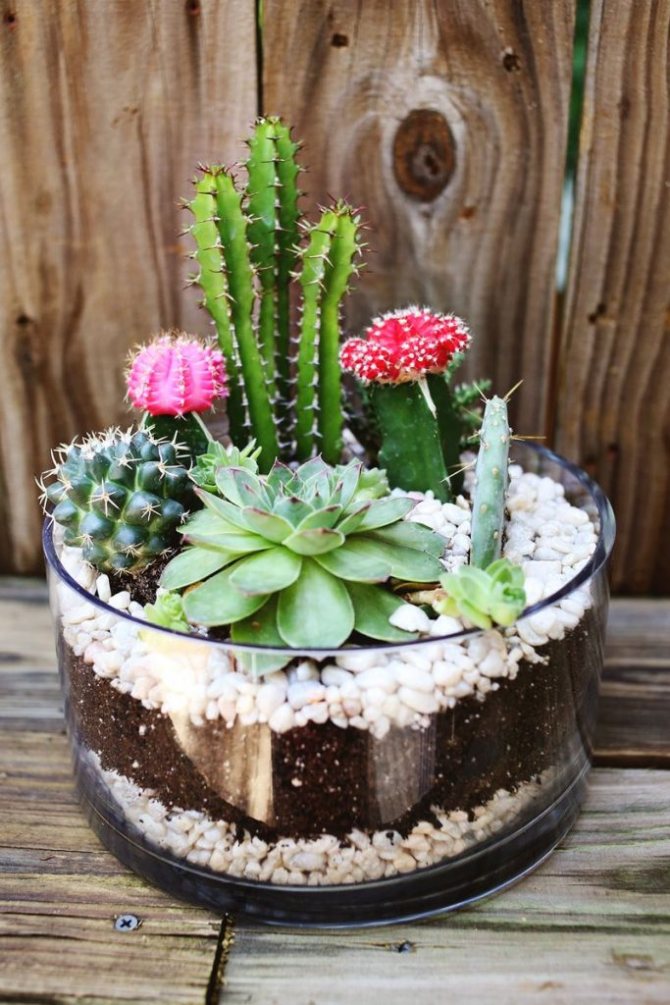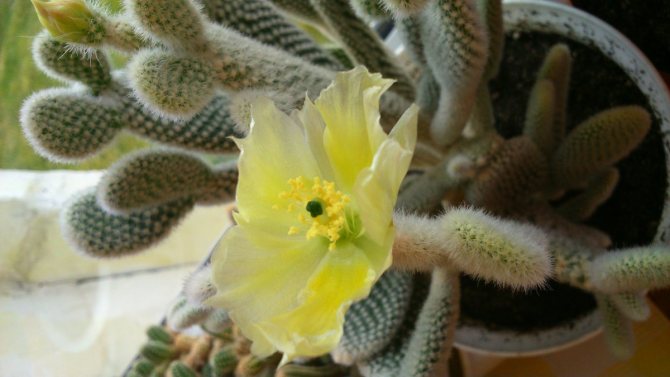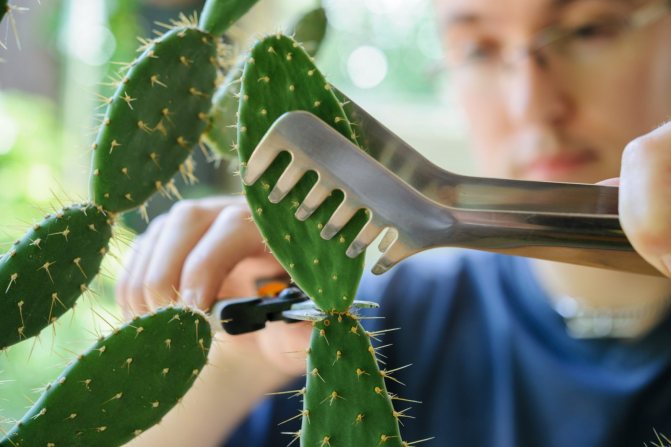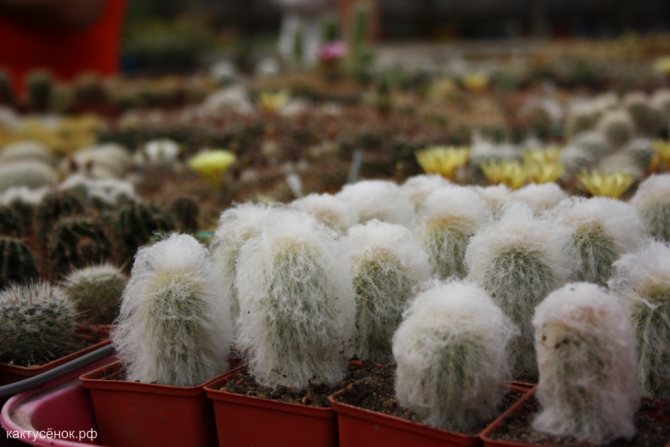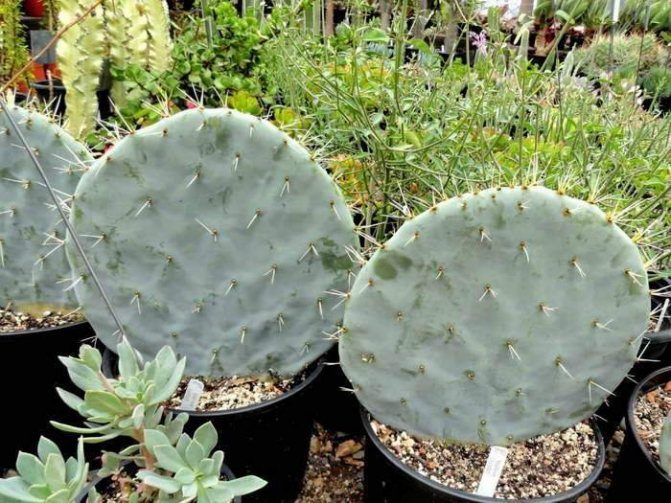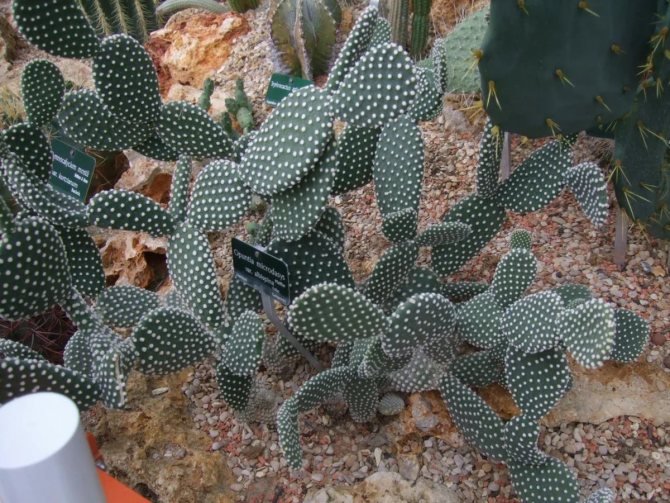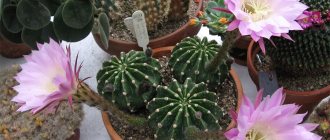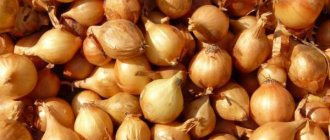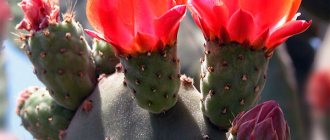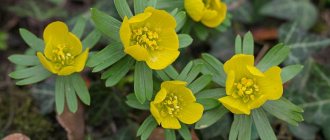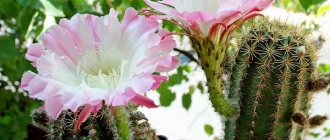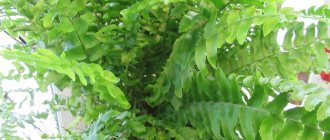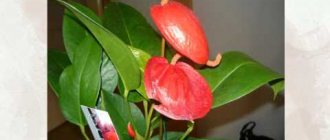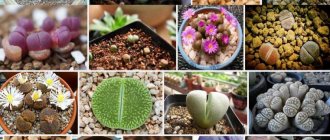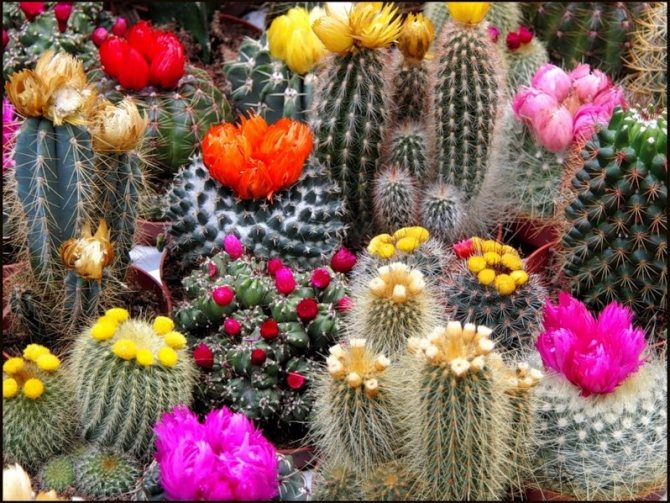
Exotic plants, completely covered with thorns, have long settled on our windowsills, because they are beautiful, unusual and unpretentious to care for. However, even if you give only the names of such popular indoor plants, you will have to write a scientific treatise in several, rather weighty volumes. Therefore, it makes sense to describe only the most beautiful and popular home cacti, photos and names of which we will provide to your attention. There is already an article on our website about how to care for cacti and water them efficiently, it is worth reading it for general acquaintance with the process.
Family
The Cactaceae family is a perennial dicotyledonous flowering plant adapted to grow in arid climates. The family unites 150 genera, which includes over 3000 species.
In nature, the plant is distributed mainly in its homeland - in South and North America, it is also found on about. Madagascar, Africa, Australia, India and the Mediterranean countries.
Cacti are divided into 4 subfamilies:
- cactus;
- pereskie;
- prickly pear;
- mauhyeny.
The article contains brief descriptions of the appearance of almost all varieties of the family - leafy, round, with long needles and the rarest and most unusual varieties of representatives of Cactus that can be kept in the house, their photos, names of indoor and outdoor plants in Russian and Latin, as well as tips for caring for decorative flowers at home.
Classification of cacti by group characteristics
All representatives can be divided into three groups:
- Pereskievs;
- Opuntia;
- Cereus.
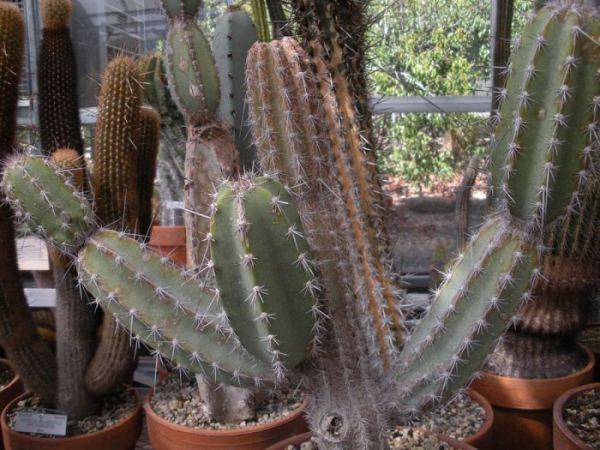

Family of Pereskiy cacti
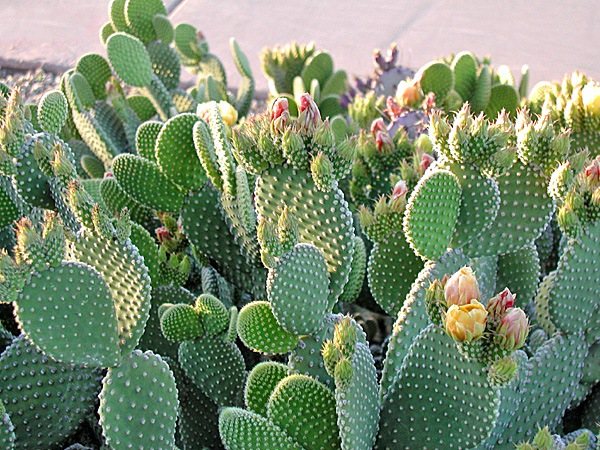

Prickly pear
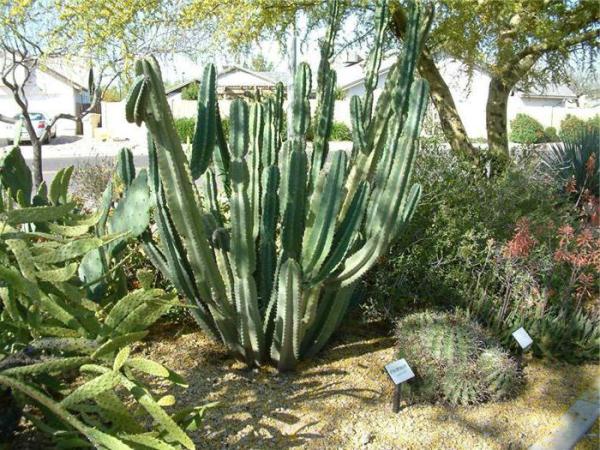

Cereus cactus family
These types differ in structure. So, Pereskievs have round stems and flat leaves.which are covered with straight spines. bloom more often as single flowers. Differs in edible fruits.
Opuntia cacti are distinguished by small leaves covered with thorns... In addition to thorns, they also have glochidia. Glochidia are the modified leaves of a plant. Large bloom. The colors are varied. The fruits are usually edible.
Cereus leaves and glochidia are absent... It is the largest family and includes a variety of species. For some representatives, the fruits are edible. Basically, Cereus cacti prefer arid areas.
What are the varieties?
Pereskia - with long leaves
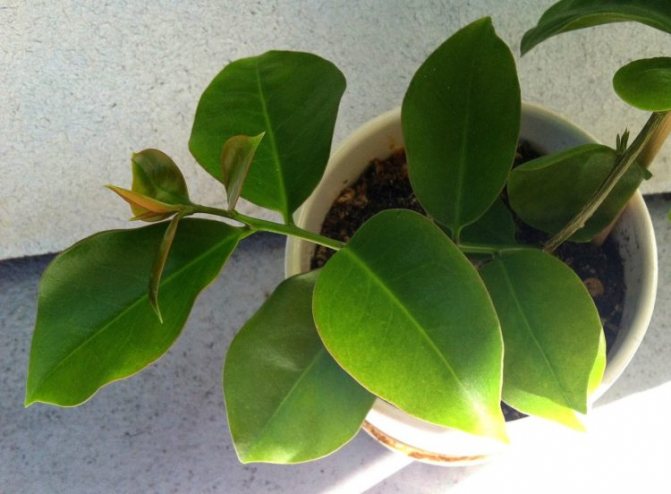

Pereskia is one of the oldest cacti, native to South America... In nature, there are about 20 species. Outwardly, they do not look like other Cactus, they are represented mainly by shrubs or stunted trees.
The stem is covered with thorns, with which they cling to the trunks of trees (and you can learn about painted cacti with stems and thorns of different colors here). The leaves are long (3-25 cm), having an ordinary oval or ovoid shape, rich green color.
The leathery leaf plate of the cactus is capable of storing moisture, and is covered with a shiny protective skin.
Pereskija is characterized by rapid annual growth - up to 20 cm per year... The plant can grow up to 10 meters in length.In the summer, the plant is covered with flowers of various colors: white with yellow stamens, pink, orange, red - in the place of which fruits are formed (we talked about cacti with red flowers in this article, and you can find out about pink cacti here).
The most popular species is Pereskia prickly.
The genus is named after the botanist NK Fabri de Peyresca... The plant has informal names: "leafy cactus" and "cactus-rose".
We suggest watching a video about the Pereskia cactus:
Cacti are the best houseplant, especially for those who travel frequently. We invite you to familiarize yourself with Astroitum, Ripsalis and Ripsadopsis, Mix cacti, Turbinicarpus, Espostoa and Echinocereus.
Hylocereus - hanging


Hilocereus - liana-like climbing or creeping cactuswhose stems hang down to the ground. There are 25 varieties in the genus. The native land of the plant is Central America; at present, the species is widespread in tropical and subtropical zones.
The stems of the plant are wide and spreading, the bush reaches a height of up to 3 meters. On the ribs of the stems, bunches of soft thorns are formed (are there any cacti without thorns?).
At the age of 2-3 years, the plant produces fragrant flowers: white, milky, yellowish or purple.
In agriculture, several types of plants are grown, under the general name - pitahaya, a fruit fruit known as the "dragon heart". The flesh of the fruit is red or white, the taste of which resembles kiwi and strawberries.
We offer you to watch a video about the Hilocereus cactus:
Mammillaria
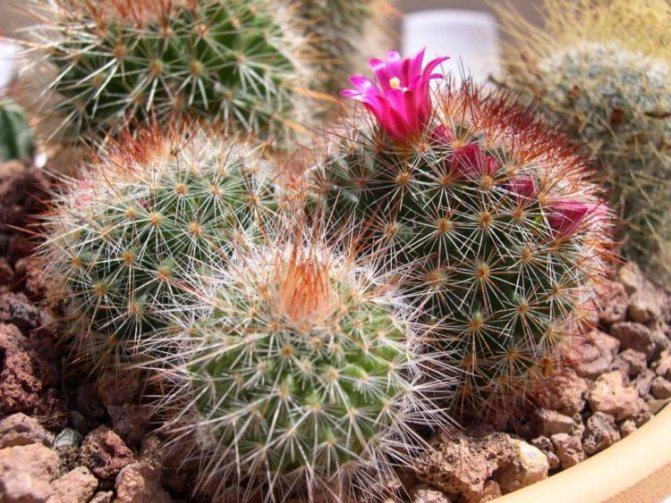

One of the most evolutionarily advanced largest genera of the family, which includes about 185 species (taking into account about 1000 hybrids). Homeland of Mammillaria Mexico and southern North America... A distinctive feature of the plant is the papillae (lat mammilla - "nipple") on the stem, from which small hairy spines grow.
Sometimes the papillae or tubercles of a cactus are arranged in a spiral or in the form of horizontal rings.
The plant is small in size, spherical or short-cylindrical (here we talked in detail about different small cacti). The flowering of the plant is abundant and beautiful. A corolla of small flowers is formed on cylindrical stems, and spherical stems can be completely covered with buds. Flowers are tubular or bell-shaped in a variety of shades ranging from white to scarlet. In parallel with flowering, fruits are found in some species.fit for human consumption.
Popular varieties are Wild, Zeyleman, Blossfeld, Baum.
We offer you to watch a video about the Mammillaria cactus:
Epiphyllum
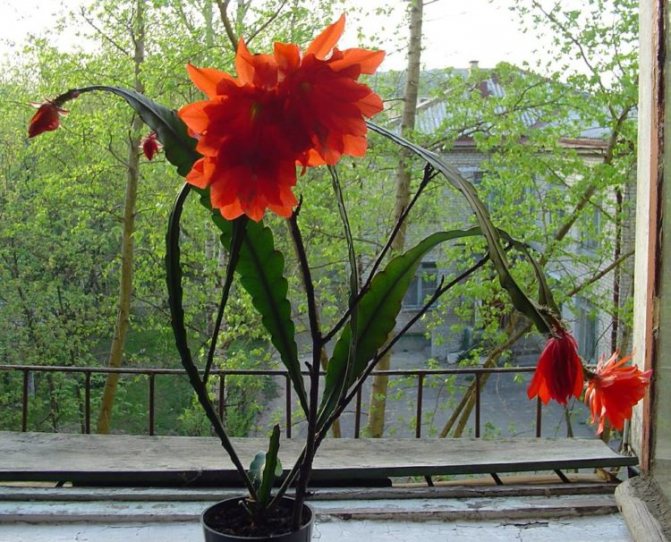

Epiphyllum - epiphytic cactus, including 20 species... Habitat - from Central America to Mexico. Epiphyllum is one of the most popular cacti in home gardening.
This genus is distinguished by the presence of long branched stems that can be mistaken for leaves. Funnel-shaped flowers can reach large sizes (up to 40 cm) - mostly white, but cream, yellow, pink and red are also found. When the buds fade, large edible fruits with a banana-strawberry flavor are tied in their place.
The plant was discovered in 1812 by Adrian Haworth and got its name from the combination of the Greek words epis - "on" and fillum - "leaf".
Hatiora
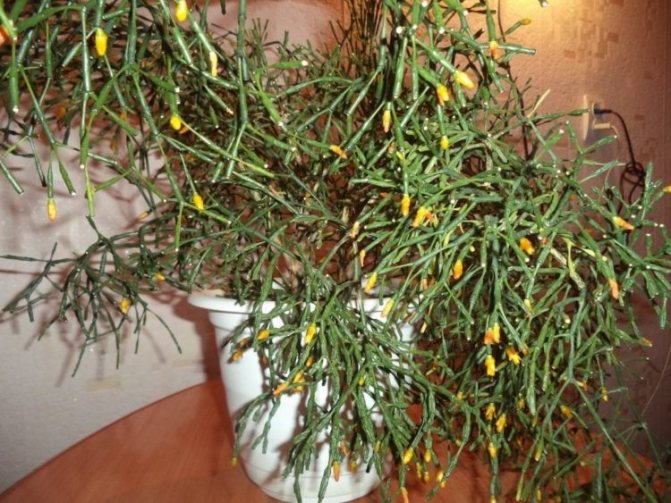

A perennial epiphytic cactus that grows on tree trunks in the rainforests of Brazil or in rock crevices. According to different classifications, there are from 5 to 10 types of hatiora.
It has thin stems, consisting of segments (segments), no more than 3 cm long. Some types of hatiors grow up to 1 m. The flowers are large, of various colors, appearing on the tops of the stems. In place of flowers at the end of summer, yellow or white berries are formed.
We offer you to watch a video about the Hatiora cactus:
Opuntia
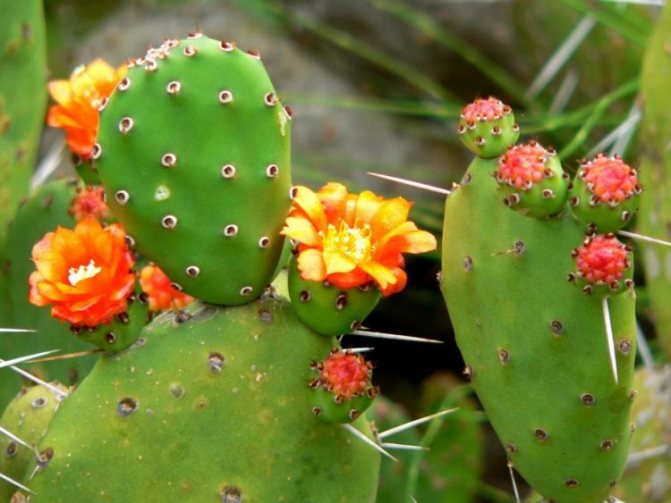

A covered-seed or flowering succulent native to Mexico. It is characterized by a wide variety of species (about 200). Differs in frost resistance, therefore it has spread to almost all corners of the world... Most species have flat, oblong stems-segments, on the surface of which buds with spines and glochidia are located (small sharp spines gathering in bunches around the areoles).
A large number of needles grow on prickly pears, which are dangerous for both humans and animals.
From the buds, flowers are formed - yellow or red, which are later transformed into edible berry-like fruits. The fruits of prickly pear are actively used for food, and the stems are used as feed for livestock..
Cereus (Céreus - "wax candle")
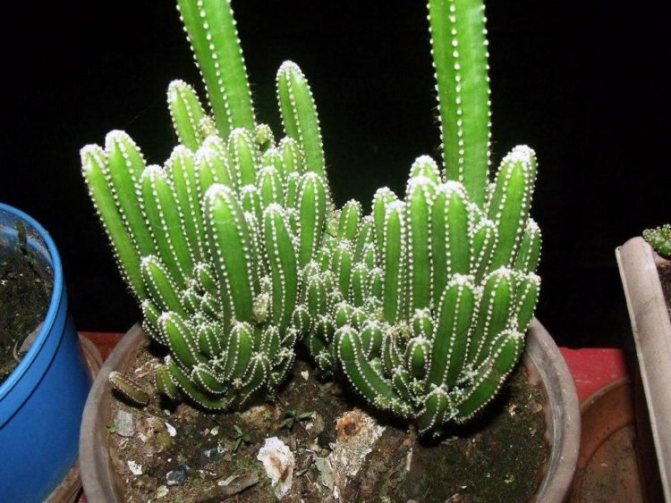

Giant cactus, common in Central and South America. Its growth can reach 20 m. Cereus is not only a giant, but also a long-liver - its growing season can be 300 years. The genus has about 50 species. The plant is adapted to an arid climate, and is able to do without water for a long time.
The plant has a branched cylindrical stem, covered with many thorns. Flowers (white or pinkish) appear on the sides of the stems in May-June, blooming only at night.
We offer you to watch a video about the Cereus cactus:
Cacti, being unpretentious in home cultivation, are present in the houses and apartments of almost every grower. But the variety of cacti is very large and we offer materials about the following species: Coryphantus, Lophophora, including Lophophora Williams, Cleistocactus, including Strauss's Cleistocactus, Trichocereus, Selenicereus and Echinocereus.
Ariocarpus
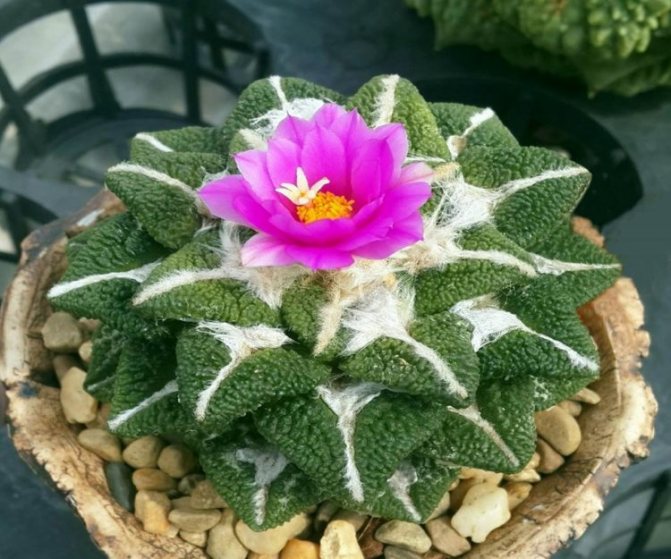

A succulent plant with low, slightly flattened shoots of a brown or gray-green hue. Ariocarpus grows in Mexico and the neighboring state of Texas, prefers stony and calcareous soil. The genus is not numerous - 10 species.
Low view, covered with papillae with pointed edges, at the ends of which there is a rudimentary thorn. White, pink, red or yellow bell-shaped flowers appear near the growing point, giving way to fleshy, round or oblong fruits containing seeds.
Aylostera
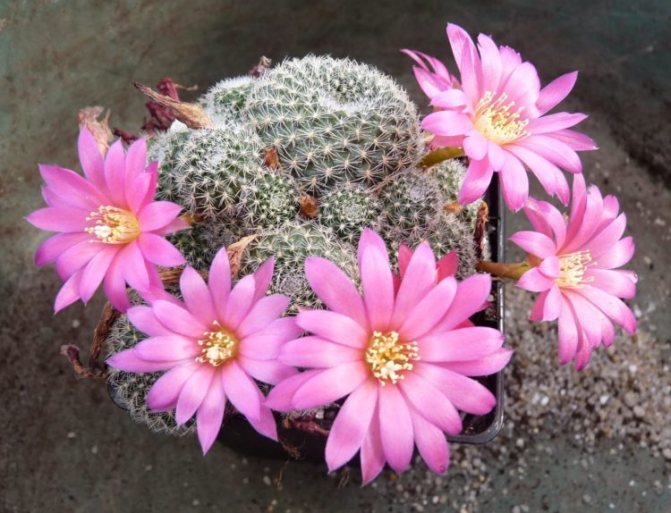

A beautifully flowering cactus with 10 to 30 plant species. Some scholars refer to the genus Rebucius (read more about rebuts in our material). Homeland of Ailostera - the highlands of Bolivia and Argentina... The plant grows at an altitude of over 3000 meters above sea level. It has an ovoid or cylindrical shape and small size (up to 6 cm in diameter). The stem is ribbed and usually many babies are formed on it. Whitish spines stick out from the areoles.
The name of the cactus is formed by merging two Greek words: aylos - "pipe" and stereos - "hard".
How to advantageously present snow cacti in the interior
Distinctive features of white cacti are completely unique very light needles and felt formations, which create the effect of a surface covered with fluffy snow-white lace or snow. Despite the fact that all cacti from this group of the genus mammillaria have a different effect of snow cover, it seems either almost furry, or like a dense cobweb, or as if hundreds of miniature dandelion seeds have landed on cacti, or even the entire surface is hidden under a thorny woolen blanket, all without exceptions snowy mammillaria in interiors play a very special role.
White cacti have a unique radiance effect, as if they illuminate the space and attract sunlight. These are tiny, but very important plants that can be equated with the crowning composition in the interior decor. The restriction on the use of these types of cacti in the design imposes the need to provide them with the brightest and most sunny locations.That is why white mammillaria are always displayed on windowsills, mainly in the southern direction. But even in such a location, this cactus can become an important touch in the design of the room as a whole.
In order to maximize the advantageous presentation of mammillaria in a room setting and to emphasize the special status of this cactus, special attention must be paid to the selection of capacity. She should not argue with the color of the edge of the cactus itself in shades, so it is better to choose pots of similar colors with a cold shade or give preference to a white palette and light pastel colors. Glossy surfaces of the pot emphasize the beauty of these cacti better than matte ones. The shape of the container, its size should reveal as much as possible not the beauty of the texture and needles of the snowy mammillaria, but the features of the silhouette, it is advantageous to emphasize the shape of the stem and lines of the plant.
Mammillaria in the interior
Snowy mammillaria are not similar not only to their congeners, but also to cacti from other genera. Despite the fact that these cacti contrast perfectly with any greenery, they should not be placed next to other cacti or indoor plants closer than 30-40 cm between containers. The thing is that in other cacti mammillaria can emphasize, "highlight" all the imperfections and against the background of the shining edge of snow cacti they will look plain and slightly neglected. As for other indoor plants of any size, from groundcover to large woody, from decorative deciduous to flowering crops, their company will negatively affect the perception of the mammillaria itself, will lead to the fact that the effect of the snow cover will be completely lost, as well as lace with fluffiness, and snow cacti will look like completely standard and unremarkable representatives of their kind.
But the additional decor will only benefit such cacti. It should be selected in accordance with the concept and style of interior decoration, from a number of materials and accessories typical for the room in which the mammillaria is located. A small scattering of decorative stones or crystals, a string of beads, sisal, ceramic sculptures and figurines, souvenirs brought from travels, if they go well with the furnishings of the rooms, can emphasize the special status of the snow cactus and further enhance its aesthetic appeal.
With long needles
Echinocactus (Echinocactus - "hedgehog")
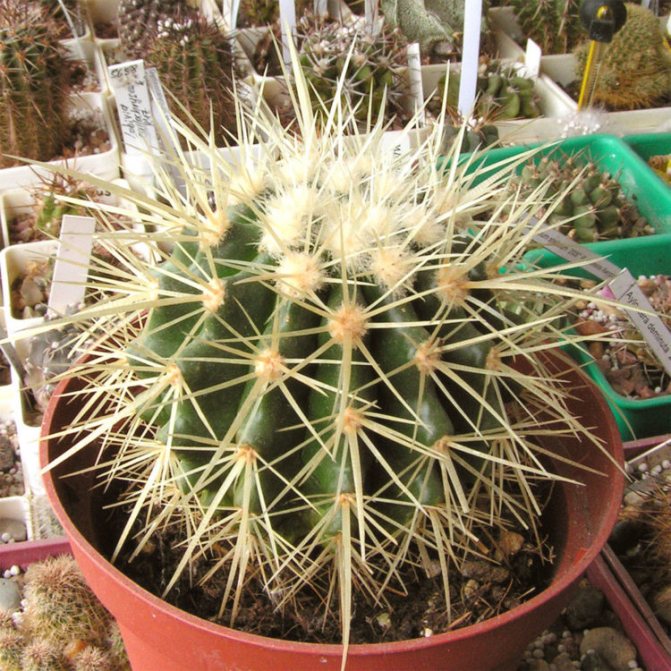

Cactus, having the shape of a ball - in young plants, the diameter is equal to the height; with age, the plant acquires an elongated shape. Echinocactus is widespread in the desert areas of Mexico and the United States (read about the types of cacti that grow in deserts here).
The average plant height is 1.5 m, the maximum is 3 m. It has numerous ribs, densely covered with thorns. Tubular flowers appear at the top and are often collected in a wreath. Echinocactus is a real long-liver; specimens about 500 years old have been recorded, with a mass of 1 ton.
The most popular type is Gruzoni.
We offer you to watch a video about Echinocactus Gruzoni:
Lobivia ferox
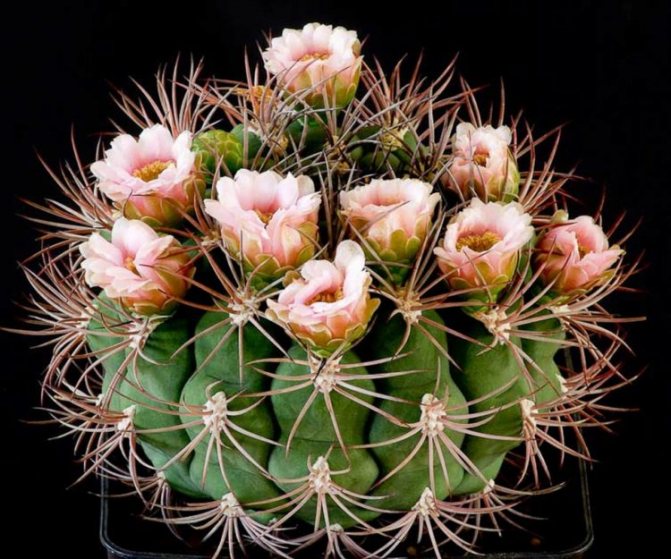

The closest relative of Echinopsis (some scientists do not distinguish Lobivia as a separate genus). There are 70-100 types of Lobivia, native to Peru, Argentina and Bolivia. The stem resembles Echinocactus in shape, but the lobivia is smaller and has large needles.
Over time, Lobivia has a lot of root babies. The main stem produces several lateral columnar stems on which showy flowers from white to bright crimson flaunt in summer.
Mammillaria black spiny (Mammillaria melanocentra)
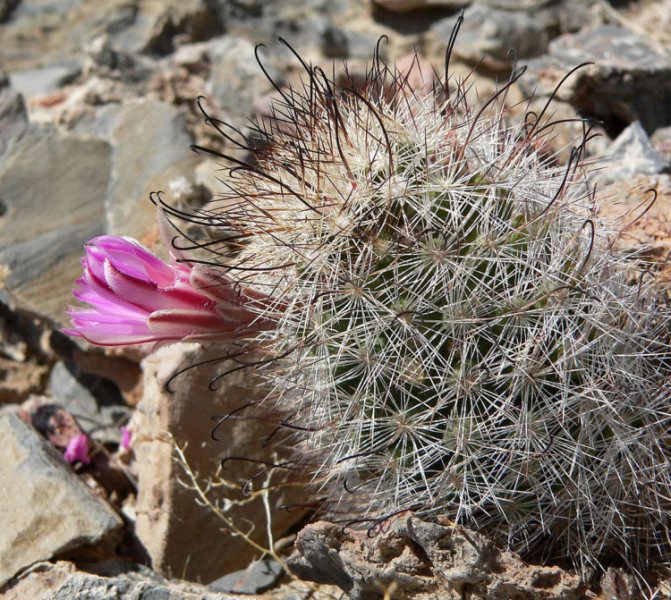

The species grows only in Mexico and settles in crevices. It has a spherical shape with an average diameter of 20 cm. The stem is abundantly covered with thorns: the lower ones are thicker and longer (2 cm), the upper ones are short (0.5 cm). The central thorn has the shape of an awl and rises 5-6 cm above the top. During the flowering period, pink flowers surround the top of the cactus with a garland.
More information about mammillaria can be found here.
Aporocactus
These unusual cacti were brought to us from Mexico and from the mighty thickets on the mountain slopes have successfully turned into popular houseplants.
Stem: branched into many thin stems, the length of which can reach one meter. The ribs on such stems are not very pronounced, the spines are bristly. At first, the stems grow upward, then downward.
Flowers: tubular, their length is about 10 cm, color - pink, crimson, orange, red (depending on the specific species).
Flowering period: can bloom throughout the spring.
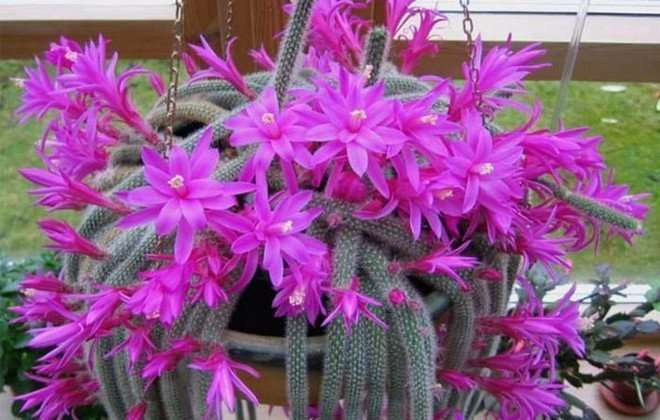

Maintenance and care: for aporocactus, the best option is bright light without direct rays (it can get burned). Good lighting is especially important during the dormant period, since the setting of buds and abundant flowering in the future depend on the light.
In spring and summer, such a plant can be placed on a terrace where there is open air, but no direct sunlight. At such a time, the optimum temperature for aporocactus is + 20 ... + 25 ° С. In winter, a bright, cool room is a suitable place for the plant.
Aporocactuses tolerate drought well, but in summer it is better to spray them with warm water. Watering such a flowerpot in the warm season is necessary regularly, not allowing the soil to dry out completely. Watering should be bottom, do not let the water in the pan to stagnate.
In winter, it is necessary to water less often, waiting until the soil is completely dry.
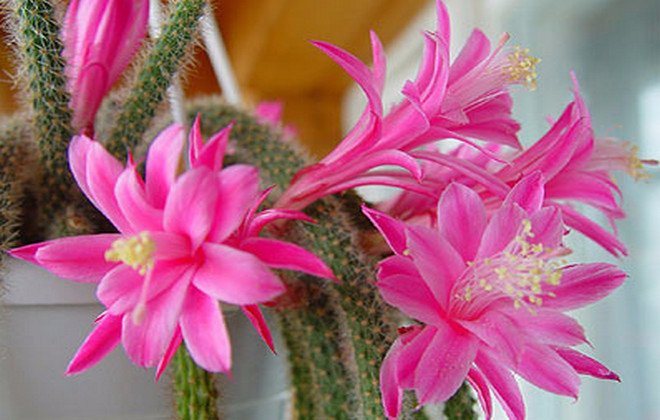

Round
Ferocactus
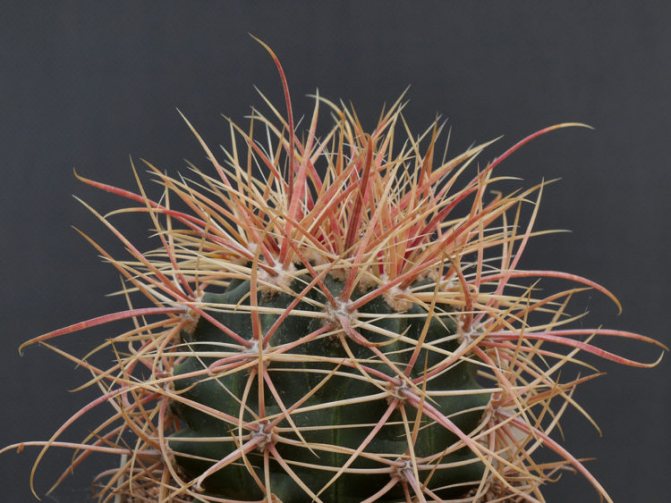

A genus that grows in North America and unites about 30 species. Most often, large spherical specimens of ferocactus are found - up to 1 m in diameter, with straight thick ribs on the stem. Flowers appear at the top only in mature plants.
Collectors highly value species with long and multi-colored thorns (red or yellow), for example: cylindrical ferocactus (or "devil's pincushion") and wide-spined (or "devil's tongue").
You can read more about ferocactus here.
Parody (Cactaceae Parodia)
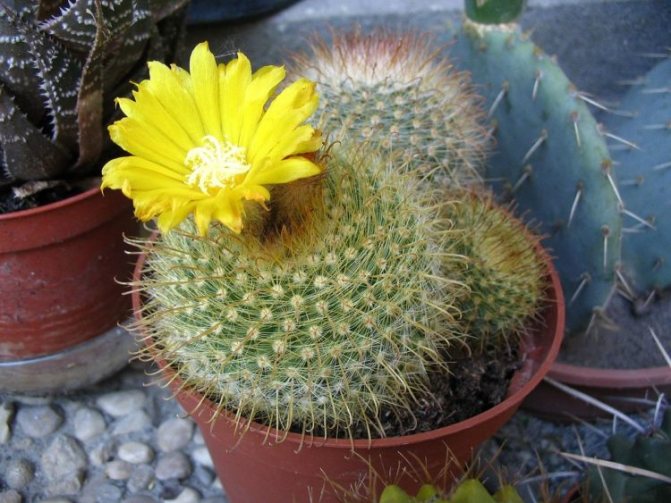

Has a second name eriocactus, it includes about 50 species. It occurs naturally in the mountainous regions of Latin America. All types are characterized by the shape of a ball or cylinder. The stem is low, with distinct ribs, on which tubercles with areoles are located. Each areola grows up to 5 long spines (4 cm) and from 10 to 40 short spines (up to 1.5 cm).
Received the name Parody in honor of the Paraguayan botanist L.R. Parodi.
Gymnocalycium (Gymnocalycium - gymnos - "cup" and calycium - "naked")
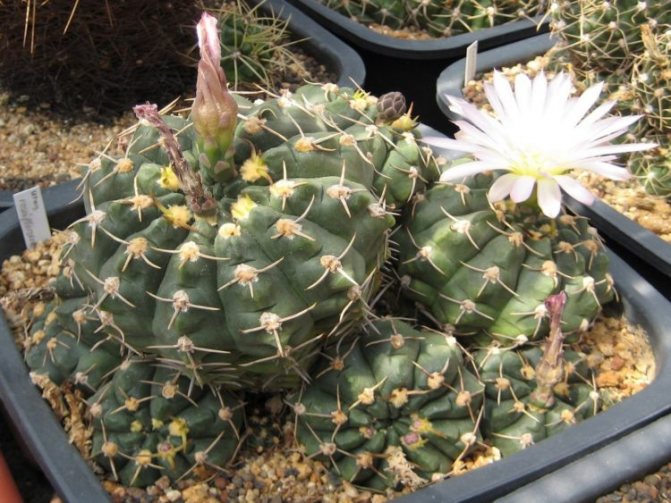

Gymnocalycium is a spherical flattened cactus of South American origin... Combines 50-80 species. Diameter 4-15 cm, height 2 times less. Differs in long flowering - from May to September. Widespread in home floriculture.
Notocactus
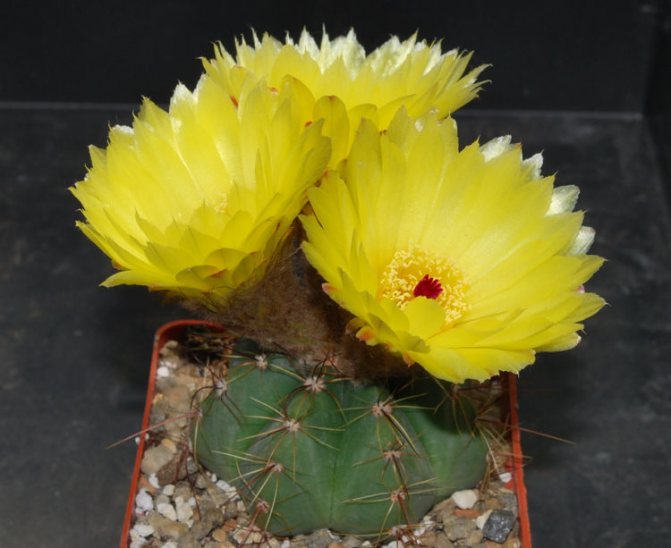

Slow-growing spherical succulent, numbering up to 20 species, is currently ranked among the genus Parodia. In its natural environment, it grows in mountainous areas.
The most popular species is the winter-hardy Otto Notocactus, which has a large yellow or red flower that resembles a gerbera.
You can find out about notocactus here, and read more about the species of this plant in this material.
Notocactus
The name of this type of cactus in translation from Greek means "southern cactus", since it was in this part of the world that they appeared.
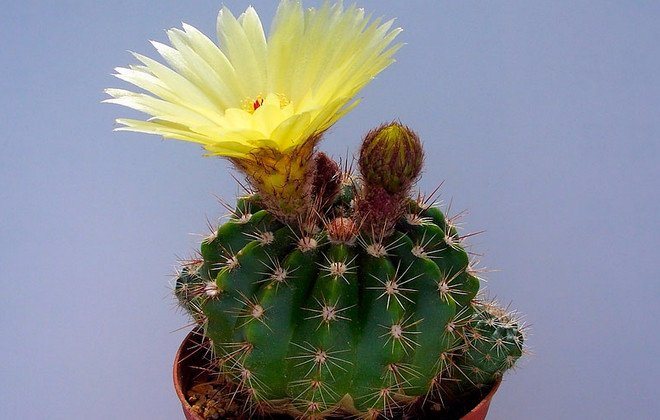

Stem: spherical or wedge-shaped with well-defined ribs and a large number of spines.
Flowers: can be of different sizes, depending on the type. The color is usually yellow or yellow-violet.
Flowering period: spring or summer, depending on the subspecies, the flower can stay open for more than 5 days.
Maintenance and care: needs bright diffused lighting. The temperature during the growing season is up to +26 ° С, in winter - not lower than +10 ° С.Water the plant abundantly from March to September and moderately from October to March. The soil must not be allowed to completely dry out. At the same time, it is not good if it is waterlogged.
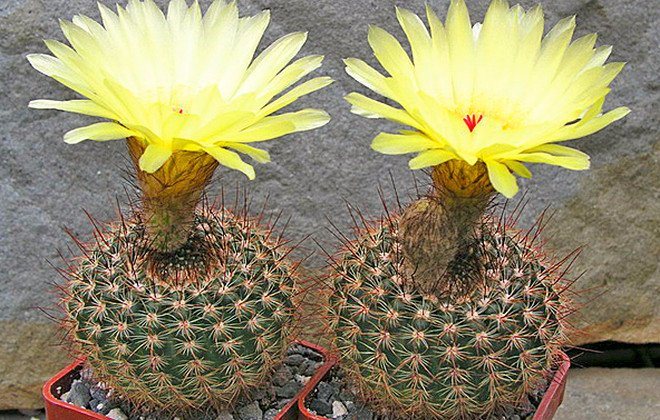

Rare
Lepismium (Lepismium - "scales")
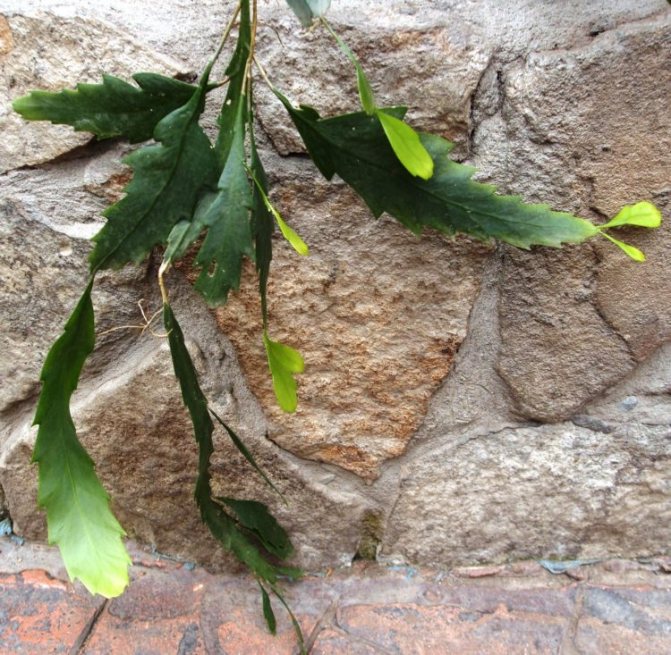

Lepismium - epiphytic forest cactus, including 10 species... It grows in tropical forests and has long drooping stems. Deep-set areoles have scales that were rudimentary leaves. Flowers are located at the ends of the stems and appear in late spring. They are often used for interior decoration.
Echinofossulocactus (Echinofossulocactus)
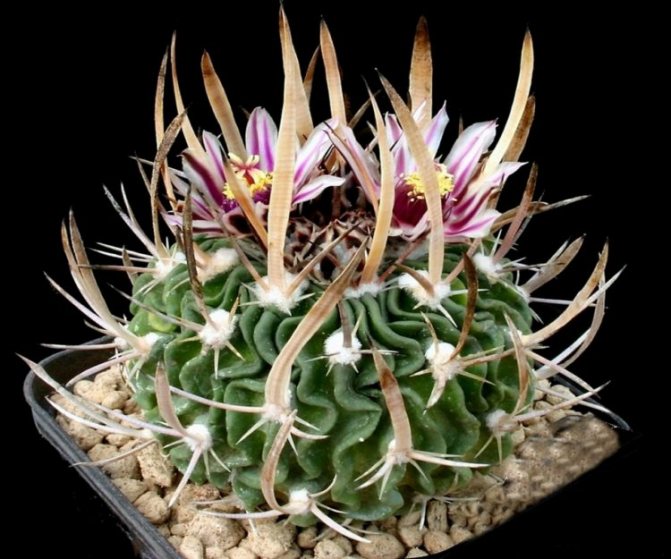

A genus of spherical cactus, including only 2 species found in Mexico. The stem is 10 cm in diameter. Areoles are located radially and from them grow curved yellow or brown spines of various sizes. The bell-shaped flowers are lilac with a white corolla.
Eulychnia (Eulychnia - "beautiful lamp")
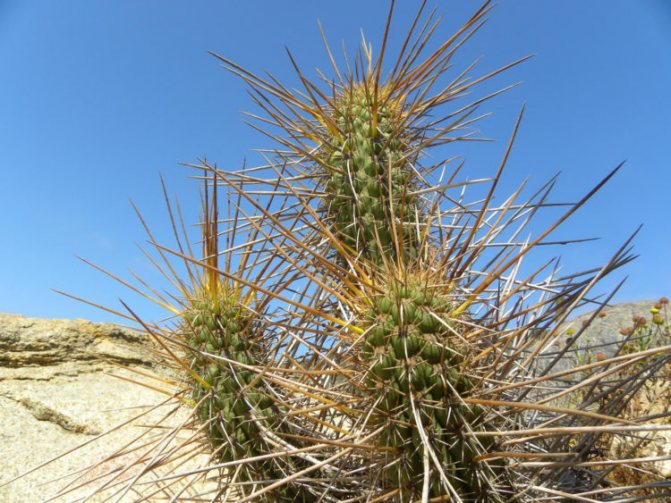

Columnar cactus, numbering 5 species, grows on the coasts of Peru and Chile. It is distinguished from other species by abundant felt or fleecy pubescence on the ribs, around the areoles (we talked about the variety of fluffy cacti here). The cactus produces the sour "copao" fruits that are eaten in places where the plant grows.
Haageocereus
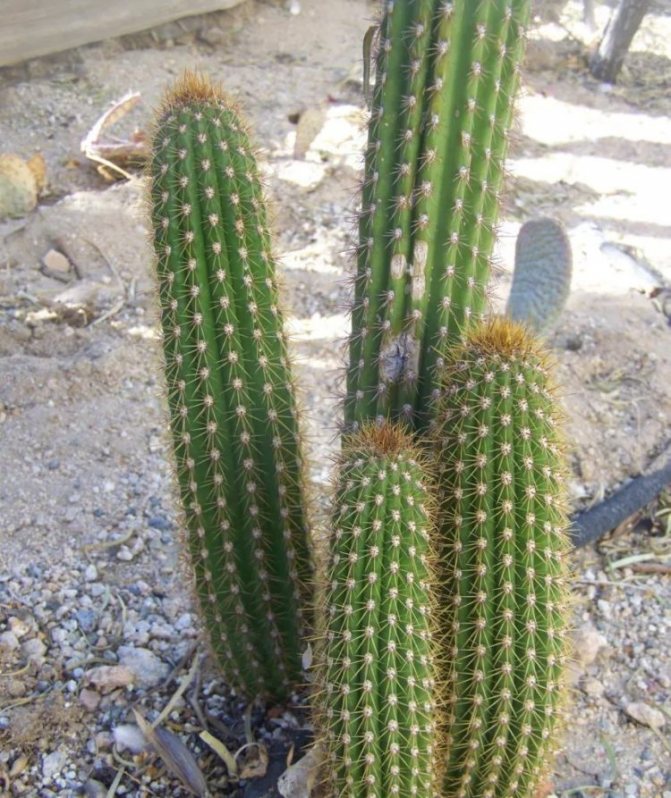

A columnar cactus native to the hilly and rocky areas of Peru and Chile. The genus includes 20 species. It has a rather high erect stem with distinct ribs. Some species take a cannabis shape. It produces funnel-shaped flowers of white or pink color, in the place of which fruits covered with hairs and scales appear.
Hildewintera
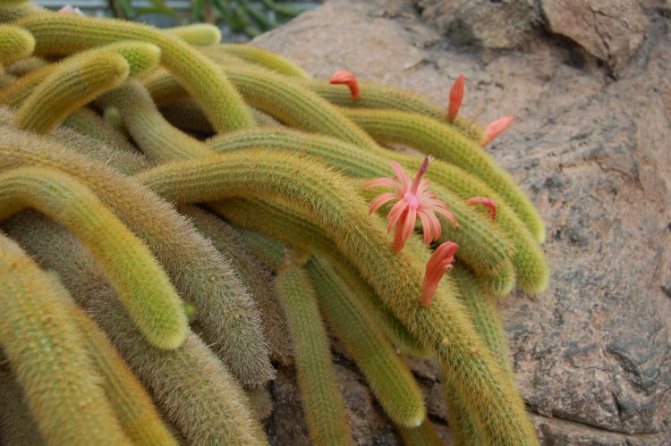

Includes about 50 species, mainly grows in Uruguay. It has creeping long stems covered with corymbose spines. Blooms in large red or orange flowers. The most popular type of Winter is popularly nicknamed the "monkey's tail" for its resemblance to the fluffy tail of an animal.
Neoporteria
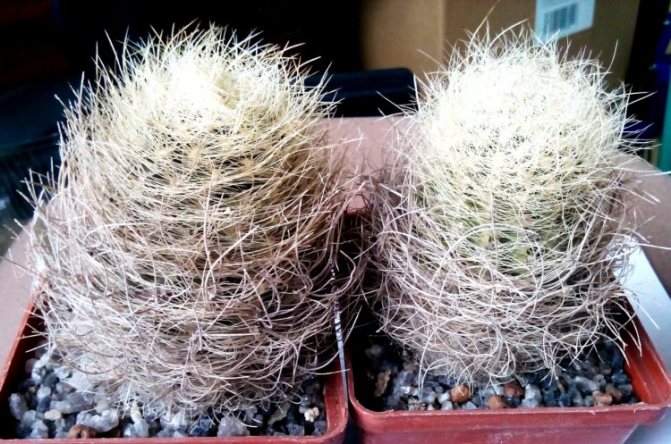

The genus Neoporteria unites about 25 species... Small, globular, single-stemmed cacti that develop into a cylindrical shape over time (which cacti are large?). Covered with red or brown long needles. Blooms every year with a large number of funnel-shaped cream, pink or red flowers.
Oreocereus
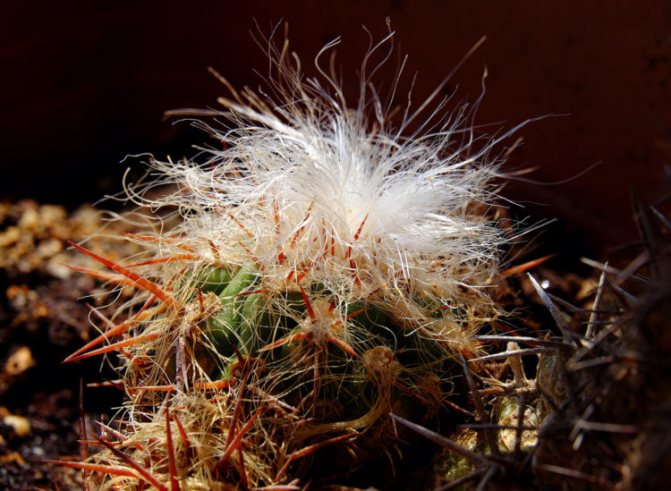

Columnar or branched cactus native to the Andes. It can grow up to 8-10 meters. Differs in the presence of not only spines, but also thin hairs, braiding the stem with cobwebs.
Pilosocereus (Pilosocereus)
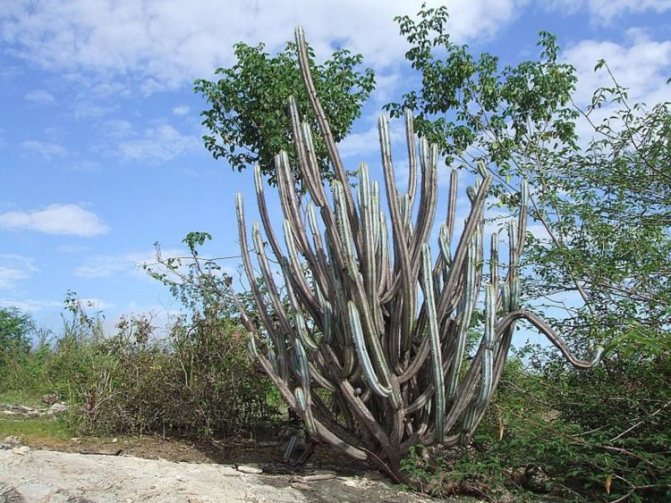

It grows in America and has about 60 species. The stem is green with a bluish tinge, grows up to 10 m. The plant is also called "hairy cactus" because a number of species are covered with dense fluff. Differs in spectacular bloom with large white or pink flowers that appear anywhere on the stem.
Setiechinopsis
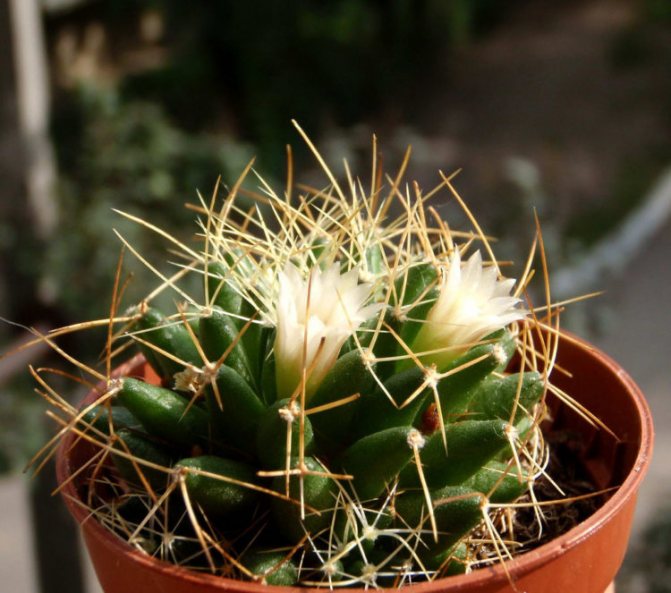

The cactus has only one species - Mirabilis, common in the east of Argentina... Stems are cylindrical brown-green, no more than 15 cm in height. During flowering, it releases a long tube, on which a beautiful white flower appears.
Stetsonia
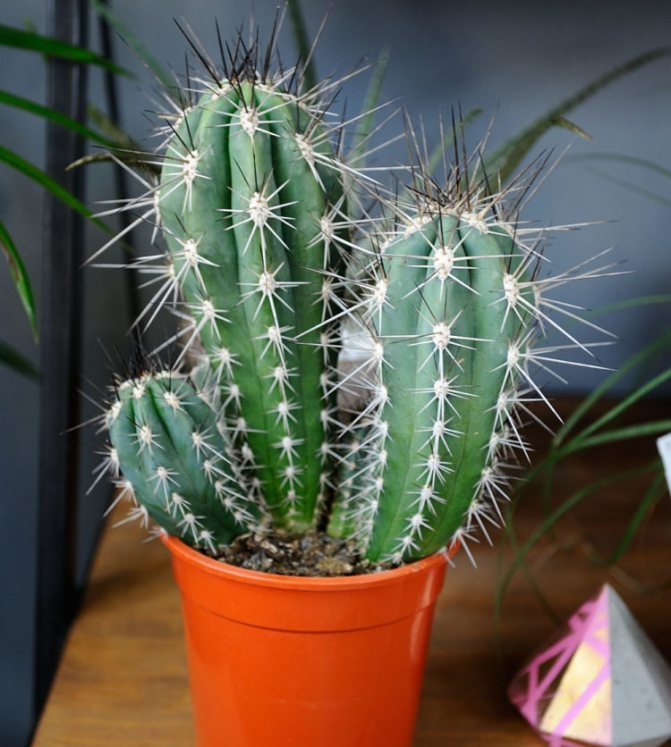

Monovid Stetsonia clavate is a giant columnar cactus (up to 8 m) that grows in Bolivia and Argentina. The stem is bluish-green with 9 obtuse ribs; sharp spines stick out from the white felt areoles. It rarely blooms with huge white flowers.
Lemarocereus (Lemaireocereus)
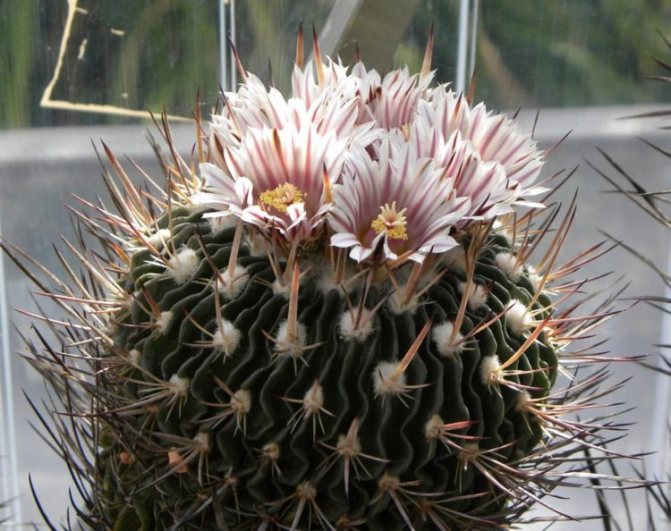

Includes 6 species native to South America. In nature, it can reach gigantic sizes (up to 15 m). Treelike or shrubby cacti with distinct sparse ribs on the stem. Thin, brittle spines line the ribs.
Berger's prickly pear (Opuntia bergeriana)
Bushy cactus, green, somewhat angular shoots up to 25 cm long, and on the buds, located throughout the entire area of the cactus, there are yellow spines.It is characterized by dense flowering, bright yellow inflorescences and a green inner part of the pistil. It can reach a height of more than 1 m. When attacked by a scabbard (red spider mite), it is necessary to treat it with soapy water.
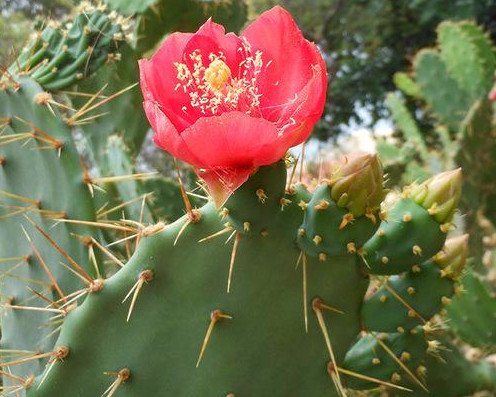

General care rules
When leaving, you need to create conditions close to the natural habitat:
- Create mandatory changes in day and night temperatures and changes in the seasons.
- Limit watering for desert cacti, and for forest cacti, on the contrary, provide abundant watering.
- Provide good illumination.
- Provide fresh air to the roots.
- Choose the right soil and drainage.
We suggest watching a video about the general rules for caring for cacti at home:
Opuntia Gosselina (Opuntia gosseliniana)
A common species native to Mexico. The inflorescences of this cactus are very bright yellow and begin to bloom very early. Mature prickly pear leaves also attract attention with their blue-green color with a beautiful gray tint, in small individuals they are purple. Ten-centimeter spines are quite soft to the touch, located only on the upper zones of the leaves.
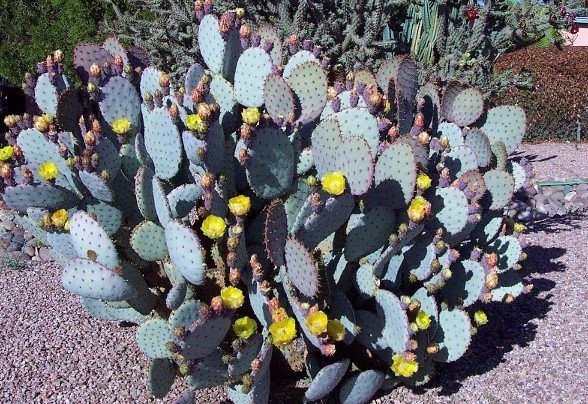

Diseases and pests
Opuntia suffers from rot when irrigated improperly, as well as high dampness in the room. If soft dark areas appear on the plant, they need to be cut off and treated with a fungicide. It is also necessary to change the conditions of detention, otherwise the cactus will continue to get sick.
Scabbards, mealybugs, aphids, spider mites occasionally settle on the stems. To get rid of the parasites quickly, a series of insecticide treatments should be carried out. Spraying rules and their frequency are indicated in the instructions for the drug.
Sheri's prickly pear (Opuntia scheerii)
A bushy branched cactus, reaching a height of 1 m. The shoots of Sheri prickly pear are large, rounded, greenish-blue, densely covered with areoles with pale yellow spines, which adjoin the surface of the stem, and elongated white hairs. It blooms very beautifully - at first, the pale yellow flowers turn pink at the end of flowering. The fruits of prickly pear Sherry are spherical and red in color. Does not tolerate waterlogging.
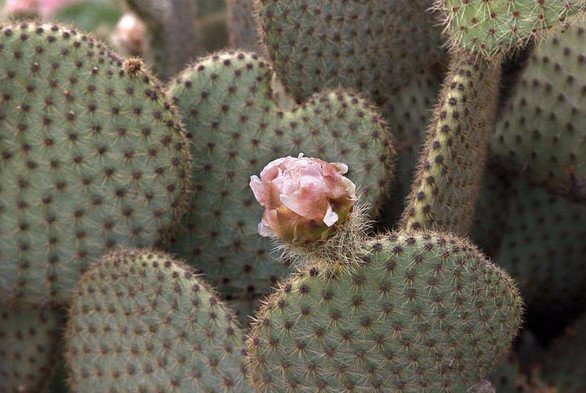

Pubescent prickly pear (Opuntia tomentosa)
A powerful tree-like plant of dark green color, in nature reaches 6 m in height. Stem segments are lined with pubescent areoles with one short spine; the surface is velvety to the touch. Flowers of this type of prickly pear are found only in old plants. To avoid root rot, you need good drainage, which includes charcoal and red brick chips. [img hint =
